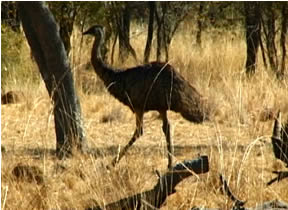
Introduction:
“Ochre:
any of several earthy mineral oxides of iron mingled with varying
amounts of clay and sand, occurring in yellow, brown, or red, and
used as pigments.” Before rock art, there were minerals from
the Earth. These minerals became valuable to the rock artists of
the Australian continent.
The
rock paintings of the original Australians demonstrate creative
uses of available materials. The most popular colours are red, white,
black and yellow, which are found throughout the continent, although
different regions favour various mixes and pigments. Some areas
provided an abundant supply of natural pigments, whereas other clans
had to trade with neighbours or travel long distances to gather
pigments for paints.
Black is easily obtained from charcoal,
white from pipeclay, gypsum or burnt selenite. Yellow was the most
difficult to obtain and occurs least often. Aboriginal legend tells
of deposits of yellow ochre in Arnhem Land, Northern Territory as
being totemic centers, the ochre being deposited there by mythological
beings. Purple and brown are obtained from ochres and the blue,
in the Kimberleys, comes from glauconite. The blues of north Queensland
come from ochre found on the Johnstone River. It is the red ochres,
which vary from pink to a deep reddish brown, that represent many
objects in Aboriginal paintings.
 |
The
colours vary with the origin of the ochres, originating from manganese,
iron oxide and ferruginous sandstone. Red was also obtained by burning
yellow ochre, clay and rocks. Near Adelaide, decorative reds were
gathered from the roots of certain plants. Once obtained, the pigments
were broken up into powders on a portable stone mortar, then mixed
with water. In areas where water was scarce, the powder was mixed
with the fat of fish, emu, possum or goanna. Animal fat also had
great penetrating properties, allowing the paintings to remain on
the rocks for hundreds of years. Some art has been carbon dated
from several hundred years ago.
Coastal
tribes often mixed the paint in shells. The paint was applied with
a finger, a brush (made of a twig chewed and teased out at the end)
or with feathers tied to the end of a stick.
Charcoal
and lumps of ochre were also used as crayons for drawing on rocks
and for decorating the body, possessions and sacred objects.
Rock art was created using ochres
sometimes mixed with animal blood collected from ceremonial rituals.
Fixatives, such as plant resins from spinifex (a desert plant) wax
or egg yolks are often added to the pigments. Pigments used in bark
painting are mainly red and yellow ochers, white (kaolin) and black
from charcoal. The colours are gathered from special sites. They
provide a soft, earthy finish to the painting.
Vocabulary:
- fixative
- pigments
-
decorative
- perishable
Materials:
- resource
books of geology and rock types
- resource
materials depicting cave art, i.e., Painters of the Caves, Patricia
Lauber
- sand
paper
- glue
- sand
- dry
tempera paint
- pencils
- spoons
- brushes
Preparation:
- Gather
clean sand, free from dirt and leaves (a finer grain of sand is
optimal)
- Investigate
various symbols that portray animals or nature
- Make
a pattern of a symbol that has importance to the student
- Simplify
designs to reproduce on to the sandpaper
Procedure:
- To
color sand, mix one tablespoon of dry paint into one cup of sand.
Mix to coat evenly, using this procedure for each container of
colored sand.
- Transfer
the symbol from the pattern to the sandpaper. Plan the colors
to be used for each section.
- Spread
the glue around the first section to be coloured. Spoon the sand
over the design, completely covering the first section.
- Allow
the glue to dry, then tap the excess sand into its container.
(tap over construction paper, then create a funnel with it to
pour sand easily)
- Continue
covering the symbol in this manner until it is completely covered
with the coloured sand. Allow to dry overnight.
Analyze
and Conclude:
- Ancient
artists created designs out of earth’s natural features by
using sand as a base. Explore
various cultures that portrayed images in sand paintings. Investigate
their ceremonial significance.
- Identify
regions around the world where cave art has been found. What steps
are being taken to preserve and protect this historical record?
- What
symbols where important to the cave artist? How do these symbols
reflect the daily life of the people? Why was this portrayal important
in ceremonies of these clan groups?
- Create
a map of Australia identifying locations of cave art. Can you
find where the ochres originated that were used in the paintings?
How did the Aboriginal people obtain the ochres that they used?
Management
Tip: use the print feature
in your browser to print this page.
|
